THE AUSTRALASIAN COLLEGE OF ROAD SAFETY

Michael TimmsMichael Timms• 2nd• 2nd35 years of Australian road policing & road safety expertise. Available for Road Safety Audits or other advisory roles.35 years of Australian road policing & road safety expertise. Available for Road Safety Audits or other advisory roles.
17h • 17h • Follow
Keep Talking Road Safety in 2024.
.
Late last year as part of the Australasian College of Road Safety New South Wales Chapter Southern Road Safety Forum, I was able to renew relations with Illawarra/South Coast media outlets to do some TV and radio news interviews and grabs.
.
I’ve been contacted several times since and it’s always good to promote road safety AND support regional media.
.
This week, in my capacity as ACRS NSW Chapter Co-Chair, I met up with the WIN News Wollongong crew in Mittagong and did a stand-up for a story about the impact of road trauma on the community. Following the interview, we discussed further road safety story ideas.
.
Next month, I’ll be appearing at the NSW Legislative Council “Current and future public transport needs in Western Sydney” inquiry. Road Safety is of paramount consideration in any review of current and future public transport needs in Western Sydney (or elsewhere).
.
One photo below is from this week’s interview, the other from 2005 (taken at Batemans Bay). Road Safety is a marathon, not a sprint race.
#roadsafety #towardszero
PLEASE PHOTOGRAPH AND/OR VIDEO ROAD HAZARDS AND REPORT THEM BUT DO IT SAFELY. NO PHOTO IS WORTH BECOMING A CASUALTY FOR.
On 17 Sep 2023, at 7:52 pm, Jonathan wrote:
Hello Damien,
FYI there is a lot of wire rope down between Barnawartha and Wodonga, on the Hume FWY. It would appear to be worse on the Nth bound alignment, but it is on both. There is about 1 km down on the Nth bound a few Km’s Nth of Barnawartha on the medium side. This has been like this for close to a month now, and the other areas have both damaged posts and lost tension at various locations and this for a longer time frame. The other areas would add up to about another Km also. I might let Regional roads know of it anyway.
Regards,
Jonathan.
Thanks Jonathan.
I’m always interested in this sort of information. A photo or video with the date and location is welcome too.
I will pass this on to the MRAA regional rep in Victoria and see what can be done with Regional Roads Victoria.
Damien
MRAA
mraa.net.au
On 29 Sep 2023, at 3:09 pm, MRAA Regional <mraaregional@aussiebb.com.au> wrote:
Hello Damien & Jonathan,
I too have been observing the unusual amount of down and damaged wire rope barriers, both directions on the Hume, and in fact all the way to Melbourne. It’s a highway I travel regularly from Wodonga – Broadford – Melbourne return, but unfortunately solo in vehicle mostly, so unable to pull over safely when I see them and at 110kph pass some of the shorter ones too quickly to even look for somewhere safe to pull over!
If as many of our riders as possible, who’re more likely to be able to pull over safely to photograph examples, and/or if travelling with others in vehicles who can video, can bombard RRV/VicRoads with hazard reports, we will get a chain of documented evidence happening, and better still, maybe they’ll actually prioritise fixing the darn things. They’re just as dangerous lying down to become entangled in. Majority I’ve seen in the last month or two, seem to be crossovers from trucks, proving again they do not stop them, maybe slows them down, but still seems to result in roll overs regardless.
https://regionalroads.vic.gov.au/contact
For urgent road and traffic enquiries call 133 RRV (133 778). Ask them for an email address to send photo’s &/or video’s
https://www.vicroads.vic.gov.au/traff…/report-a-road-issue
To report road issues which do not present an immediate danger (such as faded linemarking, small potholes or fallen signage). For all urgent on road hazards, call 13 11 70.
Regional Spokesperson – MRAA
Annabelle Cleveland MP
For anyone that is in need of any support, advocacy or has issues to raise, you can choose to visit my office in Benalla, send an email to Annabelle.cleeland@parliament.vic.gov.au, or simply dial (03) 5762 1600 to discuss your concerns.
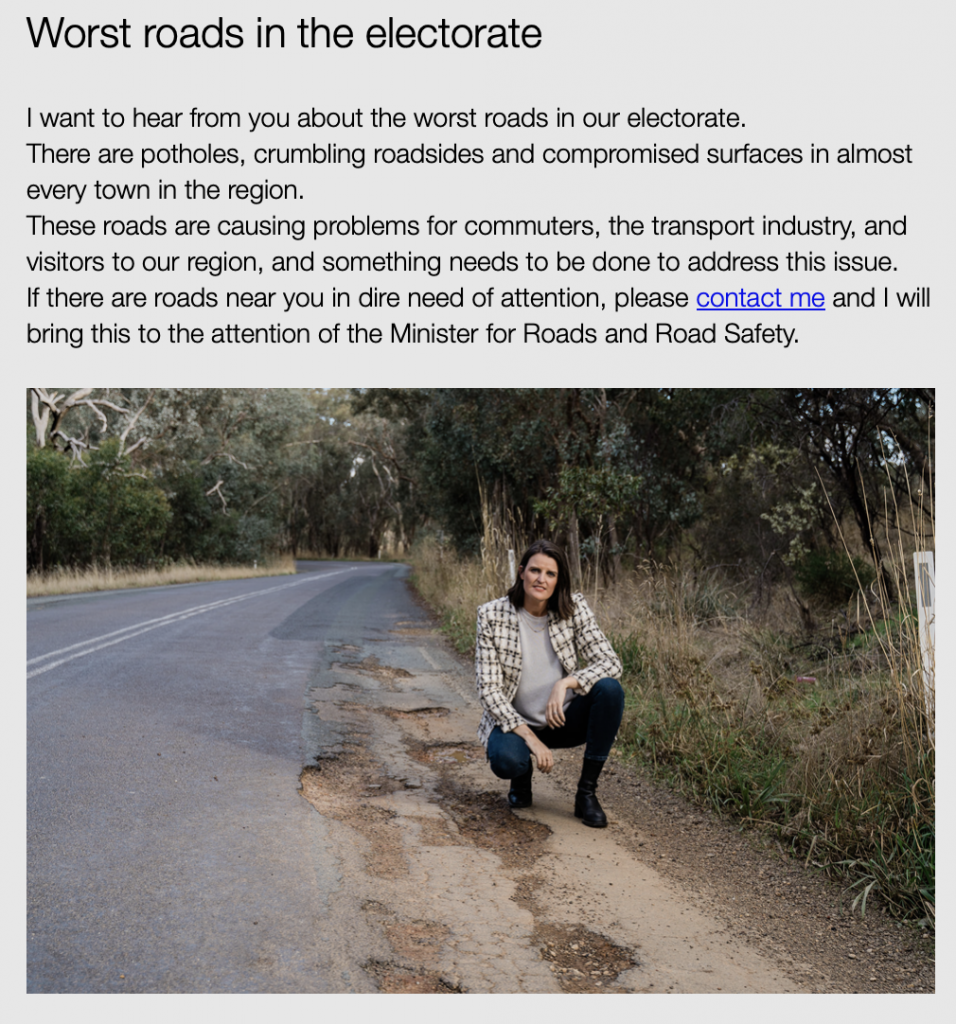
Motorcycle Awareness Month from October 1, 2023.
The Motorcycle Riders Association Australia supports the MCEP Driver Awareness Month in October 2023 and urges individual Victorian riders and motorcycle clubs to attend the launch. Please pass this information on to as many riders and interested people as you can.
“Join us (MCEP/TAC/VICPOL/DoT) for the exciting launch event of Motorcyclist Awareness Month (MAM) on Sunday, October 1, 2023 at the Skyline Federation Square. Get ready to celebrate and promote motorcyclist awareness with fellow enthusiasts and experts in the field. At the MAM launch event, you’ll have the opportunity to engage in various activities aimed at raising awareness about motorcyclist safety. Connect with like-minded individuals, including seasoned riders, industry professionals, and safety advocates. Share your experiences, learn from others, and discover valuable insights to enhance your own safety on the road. Don’t miss this chance to be a part of the Motorcyclist Awareness Month launch event. It’s time to come together and make a difference in the motorcycle community. Mark your calendars and join us for an unforgettable day of fun, education, and camaraderie!When? Sun, 1 Oct 2023 10:30 AM – 1:30 PM AEDT. Where? Skyline @ Federation Square, Russell St Ext Melbourne, VIC 3000.
This is a free event. For more information: https://www.eventbrite.com.au/…/motorcyclist-awareness…Organised by Motorcyclist Awareness Month – an initiative of the Victorian Motorcycling Community Engagement Panel (MCEP) and is supported by the Transport Accident Commission, the Department of Transport and Planning and Victoria Police. Share the Road. Keep Everyone Safe.”
The MRAA ran Biketober with 10,000 bike Driver Awareness Rides and displays in major shopping centres back in the 1980s. The first MCEP Motorcycle Awareness Month in 2022 generated very little publicity and therefore very little car driver awareness. However, the first aim of the MRAA then and now was and is ROAD SAFETY so I reckon we are obliged to promote and publicise this campaign. The attached poster is for the 6th MRAA Motorcycle Month in 1985. The campaign had gone national by then. The clipping showing bikes on the Tullamarine Freeway is from the Melbourne Sun in during the MRAA Driver Awarenes Month in 1983. The TV news reported 5000 bikes on the Tullamarine Freeway. Another channel reported up to 10,000 bikes left the car park opposite the Melbourne Zoo. They travelled to the airport loop and back to the Showgrounds to the MRAA Motorcycle Expo.
Damien Codognotto OAM
Spokesperson
The Motorcycle Riders Association Australia
GRAPHS
VicRoads, TAC, Police & the federal government refuse to produce any graph which shows an improvement in motorcycle safety. We have asked repeatedly. The MRAA created one.
Risk is a comparison that takes into account the number of riders on the road not just the number of fatalities. VicRoads, Police, TAC, etc. simply take the raw numbers and suggest that motorcycle safety has got worse when in fact it has improved. If the number of riders doubles but the number of fatalities remains the same then risk has in fact halved. You’ll never hear that from any government department.
The graph was not meant to be published without context and usually is attached to some other report or article.
Motorcycle safety has improved. The missing context is that in the last 10 or so years, since they abolished Victorian Motorcycle Advisory Committee (VMAC), removing the MRAA rep. VicRoads replaced it with a series of smaller committees. There is less expert input and motorcycle safety improvements have stalled. The graph flattens indicating the biggest improvements are in the first 10 years.
VMAC was much larger than the current Victorian motorcycle committee, about triple the size. Independent MCEP members are appointed by Vic Roads. VMAC reported directly to the Minister so VicRoads had less power to vet suggestions.
The 2023 committee is the Motorcycle Community Engagement Panel (MCEP). The new committees (they keep changing names) have been criticised as rubber-stamping government policy and for implementing policies that are not research-based. This is frustrating because the MRAA has repeatedly asked these committees to follow up on issues that have the ability to make a significant difference to motorcycle safety.
The auditor general found that 2/3 of motorcycle crashes were not in the TAC database and 1/3 of them should be. That means that the number of riders out there is 3x higher than is currently recognised and half of those riders should be included in the stats. If the number of riders is double that which the TAC uses to calculate risk/costs then the risk would halve for the rider population. That means premiums might fall, or at least not rise, because they’re overestimating risk for the average rider by a large amount. The worst part is if the stats are out by this much they tend to apply road safety interventions to the wrong places. This explains why road safety is not improving and why the numbers jump around so much each year.
The motorcycle safety levy that we’re all paying for has generated millions and is significantly underspent. There’s no excuse for not doing the research. In fact, we are wasting money doing research because the Monash researchers we tasked with getting to the bottom of the missing data excluded the very data they needed to answer this question. They didn’t realise because nobody told them and they had failed to solicit external input. Nobody has followed up and held anyone accountable.
It’s very obvious that the current “expert” committee, MCEP, lacks expert and independent opinions and is too small to do justice to these issues. A larger committee is required if you want a range of experts rather than a rubber stamp. The original VMAC was formed for exactly this reason.
Dr Michael Czajka PhD
The MRAA Road Safety & Research Officer.
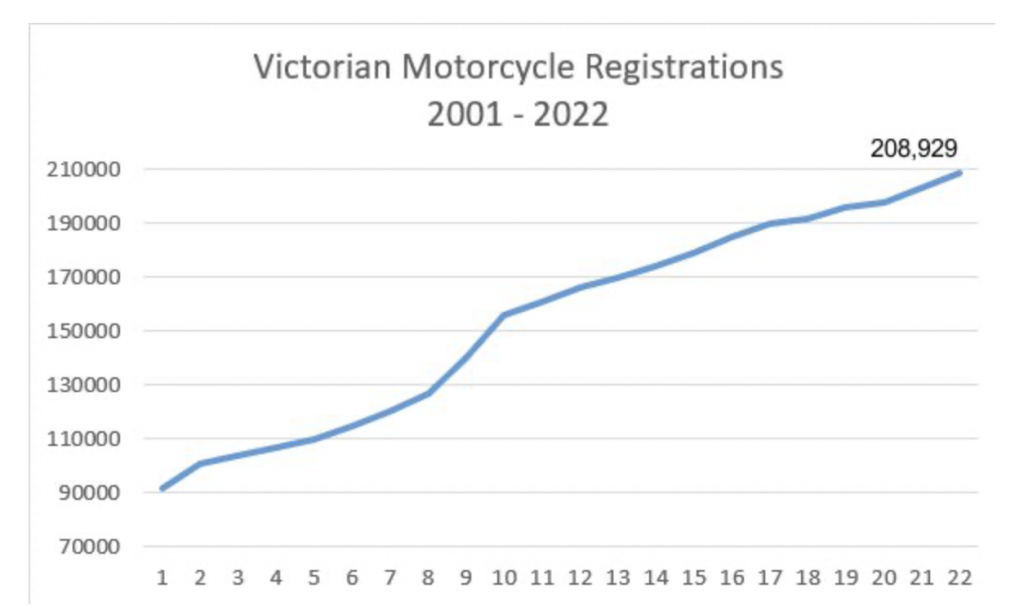
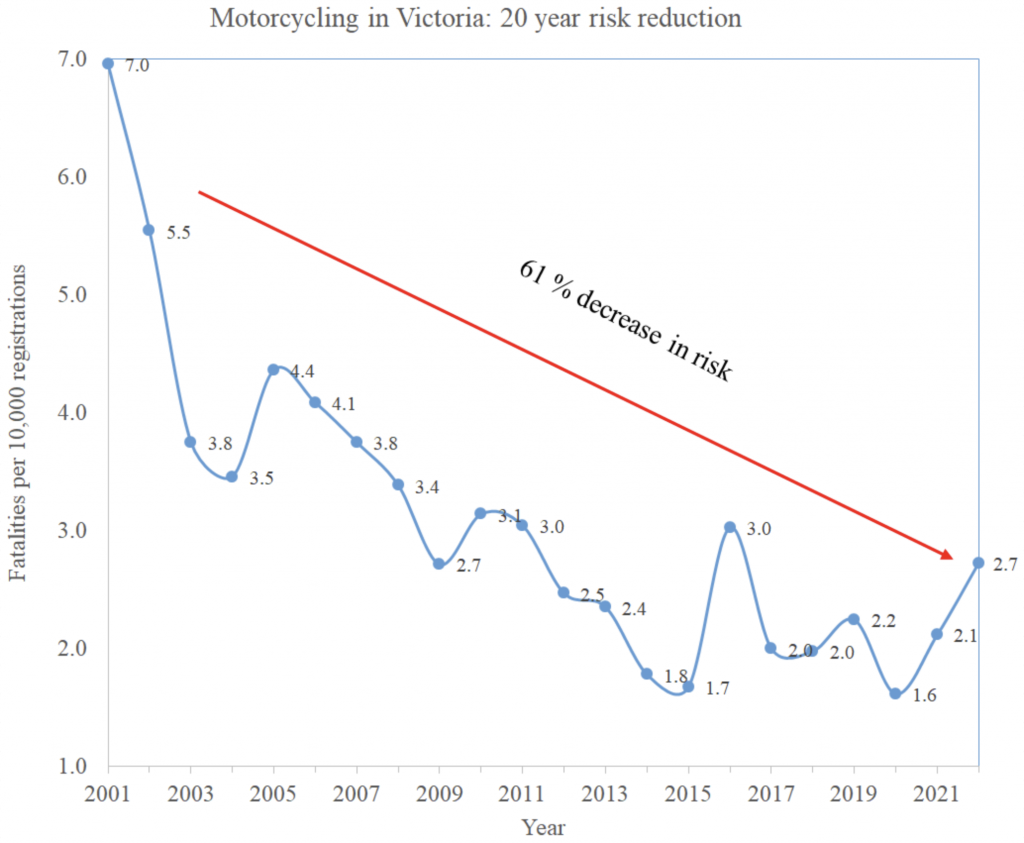
Risk graph by Dr Michael Czajkz PhD. Registrations graph by Steve Bardsley MBA, MRAA Rider Safety Representative.
LIGHTS-ON LAWS
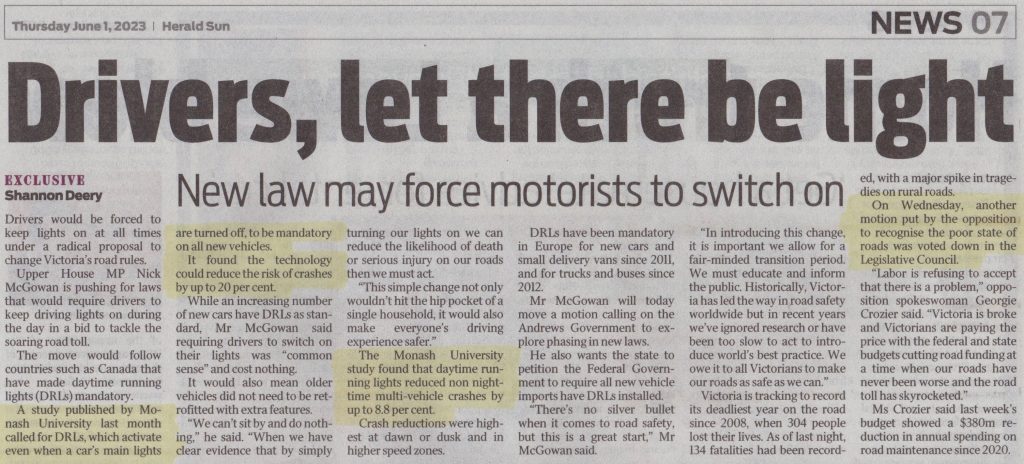
The Melbourne Herald Sun Editorial and letters. June 2, 2023.
Email: hsletters@heraldsun.com.au Text: 0499 972 948.
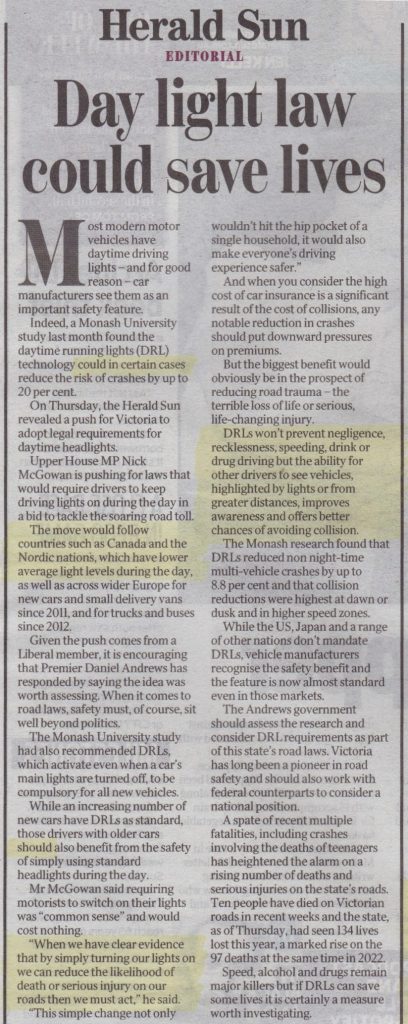
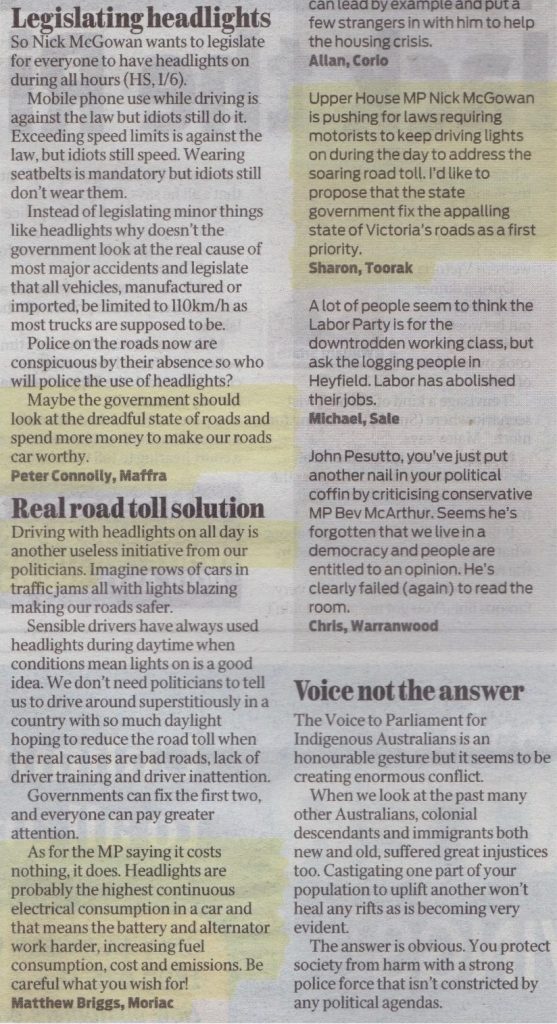
The term “lights-on” means use of vehicle headlights in daylight.
“When we have clear evidence that by simply turning our lights on we can reduce the likelihood of death or serious injury on our roads then we must act.”
Where is this clear evidence? When was the research done and where? What kind of headlights was the research done on and in what situations? Is this another case of MUARC leading the media around by the nose.
The Motorcycle Riders Association Australia (MRAA) has been calling for research into lights-on for road motorcycles & scooters since the 1992 Victorian Parliamentary Inquiry into Motorcycle Safety (PIMS). As far as we know no unbiased research has been done on motorcycle lights-on or car lights-on.
Crash and injury data exists for 10 years before and 510 years after the introduction of the lights-on ADR for motorcycles but, in spite of recommendations to undertake this relatively simple and inexpensive research, it has not been done.
It seems certain that lights-on introduced as state/territory laws creates a legal minefield. Revs Magazine commissioned a law firm to look at the roadworthy/insurance consequences for motorcyclists after a crash if the car driver told police “I did not see the bike. It did not have its’ light on”. Lights-on can only be done nationally as an Australian Design Rule (ADR). The question is. Will it reduce the road toll? It has not reduced the road motorcycle and scooter toll.
Lights-on for motorcyclists creates safety problems that have never been studied in spite of repeated requests and the huge road/CTP/levy costs riders contribute to the system.
Coming out of the sun lights-on hides riders.
A single motorcycle headlight gets hidden in a line of cars with headlights blazing.
Approaching intersections a single bright headlight makes it harder for car drivers to judge the speed and distance of the motorcycle.
Newer types of headlamp can dazzle riders and drivers.
Damien
MRAA
www.facebook.com/damien.codognotto.9
LAW INSTITUTE OF VICTORIA
I have had a call from a bloke in Western Victoria (May 23, 2023). He dropped his bike because warning signs at a roadwork site had been removed before the site was properly cleaned up. Gravel brought him down. He wants compensation from Regional Roads Victoria.
If you’ve had a crash and need legal advice contact the Law Institute of Victoria. Tel: 9607 9311. Email: inquiries@liv.asn.au
Get all the info on the crash into one folder – written material drawings, photos, videos, a list of witnesses and officials contacted and so on.
In my opinion the only way Victorian roads will become safer is if road authorities have to explain themselves in front of a judge.
Damien Codognotto

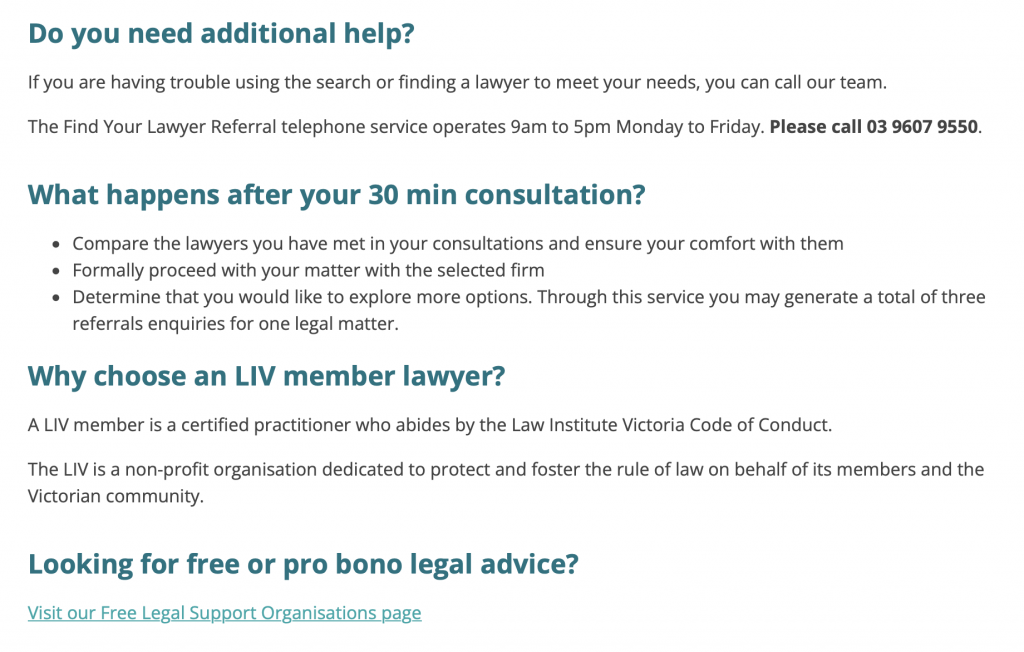
STOP LINES COMPLIMENT TRAFFIC FILTERING
MOTORCYCLE & SCOOTER stop lines are accepted in other countries. They work. They improve traffic flow and make motorcycling in traffic safer.
The Motorcycle Riders Association Australia (MRAA) made submissions to the City of Melbourne’s (CoM’s) motorcycle committee to install motorcycle stop lines at suitable intersections. Motorcycle stop lines were put in the Melbourne Motorcycle Plan as item M8.
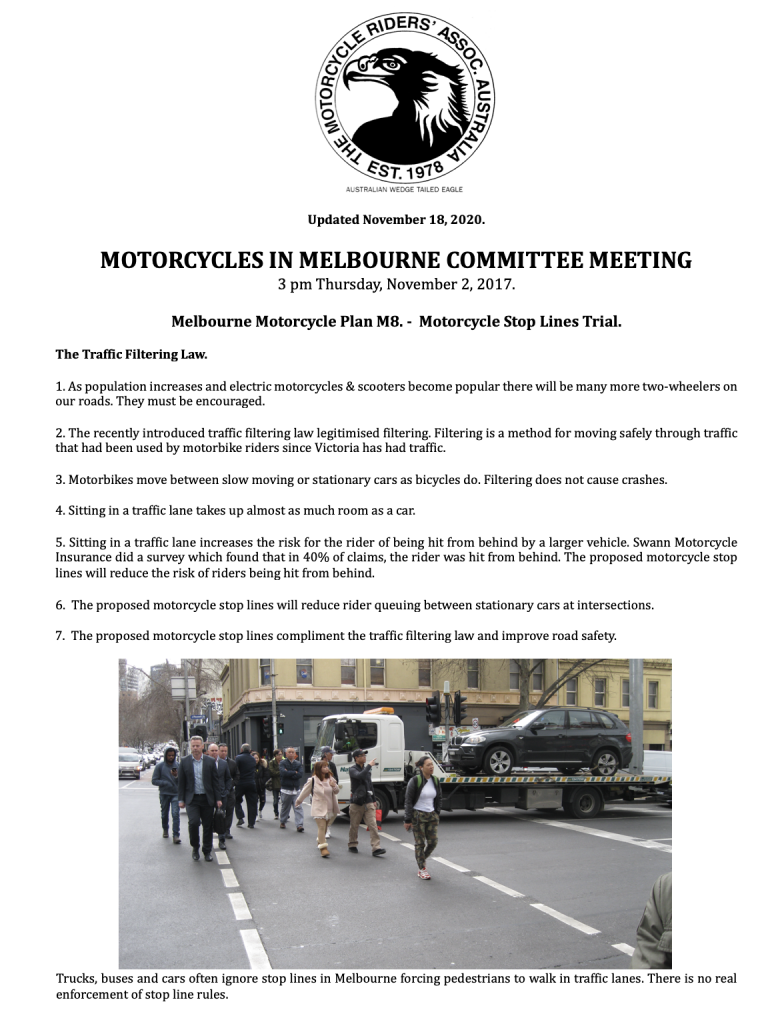
The City of Melbourne installed bicycle stop lines without trial or study. They work. They improve traffic flow and make bicycling in traffic safer. The rules changed and bicycle stop lines were installed.
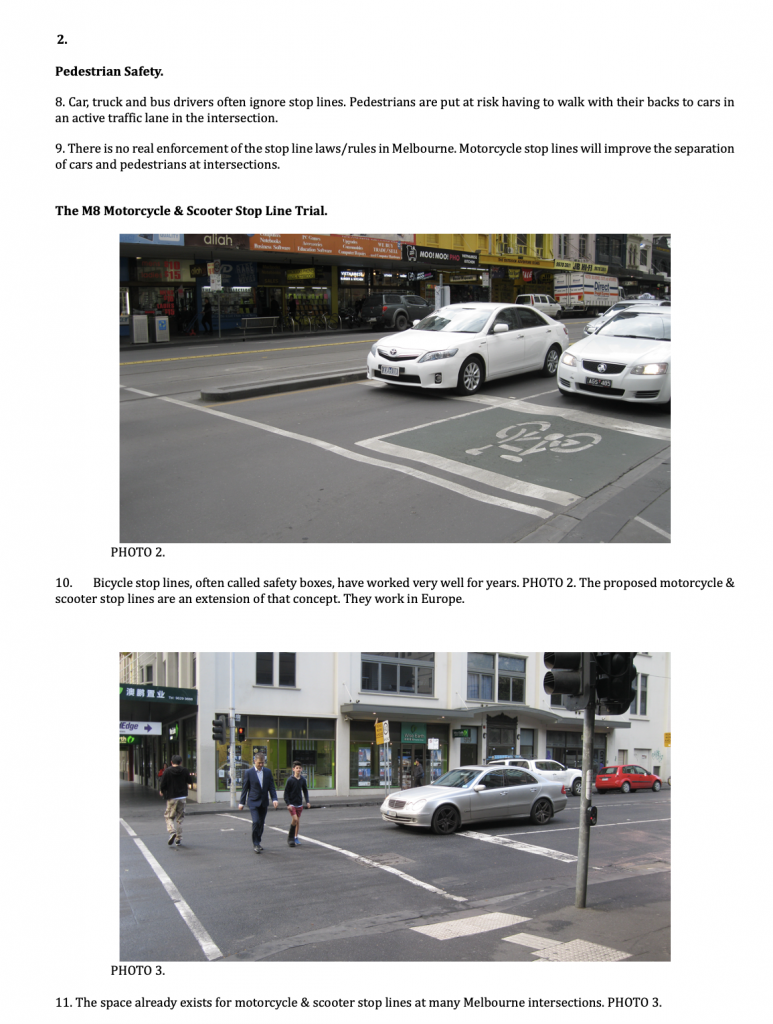
However, under pressure from VicRoads the City of Melbourne insisted on a trial of motorcycle stop lines in the CBD. These two tax/rate payer funded road authorities spent over $40,000 hiring The Australian Road Research Board (ARRB) to conduct a feasibility study on a trial. That is a study to say if a trial could be done. Not a study to see if motorcycle stop lines would or would not work.
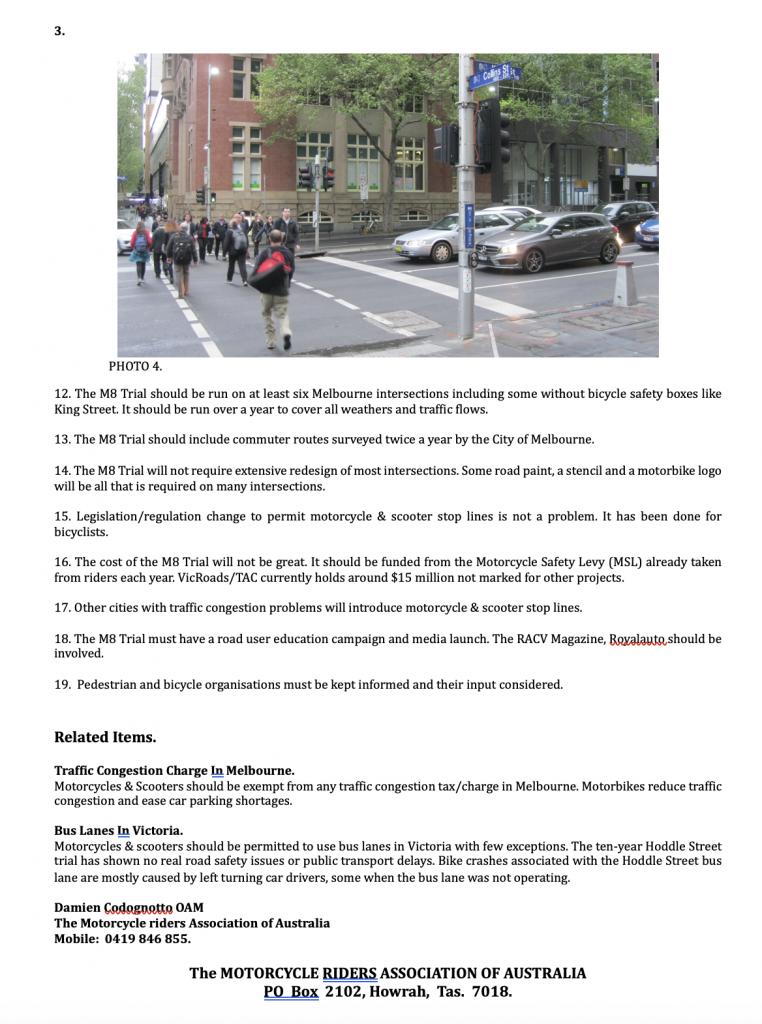
The costly ARRB feasibility said a motorcycle stop line trial was not feasible. It was an expensive way for the CoM to say no to a trail. In my opinion a trial was likely to show motorcycle stop boxes worked as well as, or better than, bicycle stop lines/boxes. Again, in my opinion it was a deep seated bias, a prejudice, against the Victorian motorcycle community at VicRoads.
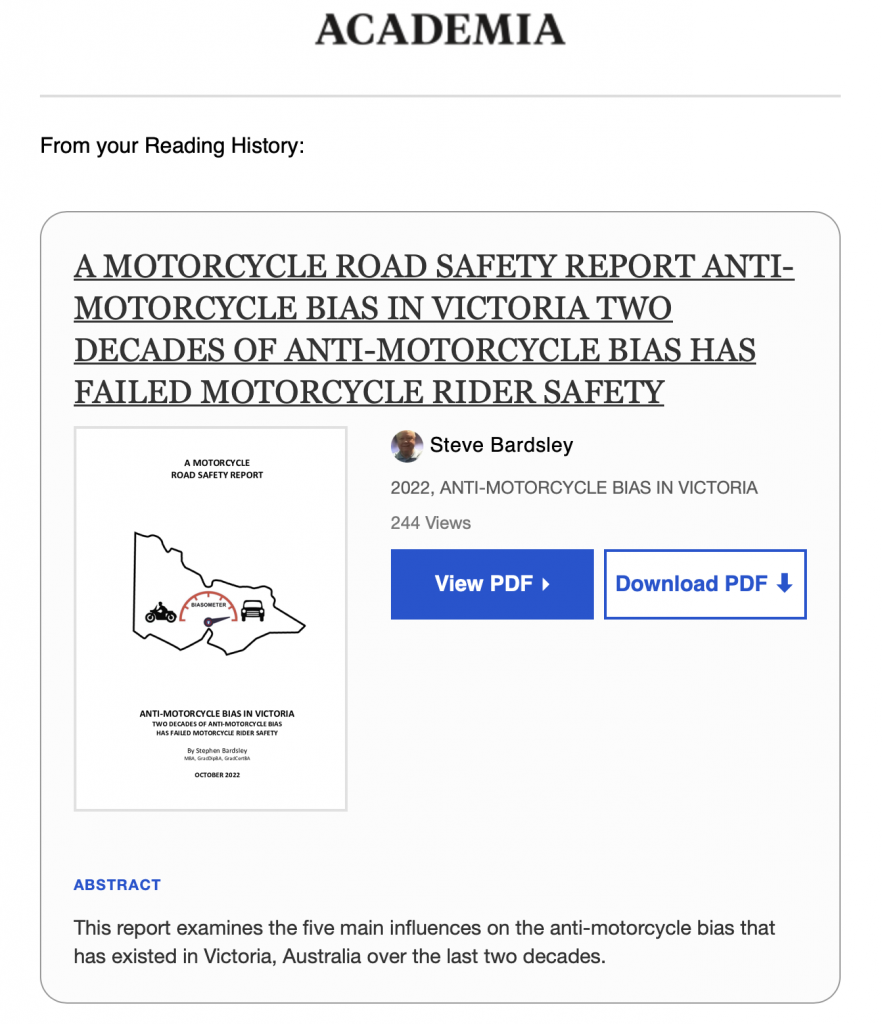
Steve Bardsley MBA is a member of the MRAA Executive. His work is now. You can read his papers at academia.edu
Damien Codognotto OAM
MRAA
AAA CALS FOR ROAD CRASH DATA TO BE FREELY AVAILABLE
The Motorcycle Riders Association Australia agrees. Secretive road authorities in this country are an impediment to improving road safety. This is clear from the steadily increasing number of major property damage, serious injury and fatal road crashes.

Two things are obvious in Victoria and elsewhere. Numerous Parliamentary road safety inquiries have documented the lack of reliable crash and traffic data available and the need to address the systemic failures in research organisations and in tax payer funded departments. Bureaucratic inertia gets in the way. One. Systemic failures are not addressed and the road toll rises. Two. Expensive, outdated media campaigns have limited value using funds that could be put to more effective use.
The TOWARDS ZERO campaigns have zero credibility with much of the road using public. The original campaign, VISION ZERO came from Sweden to Victoria decades ago with Claes Tingval. Someone pointed out that a zero road toll was impossible unless Australians were banned from ever using our roads so the road authorities modified what was silly to what was slightly less silly, TOWARDS ZERO. Apparently not embarrassing a colleague was important. The road toll rises.
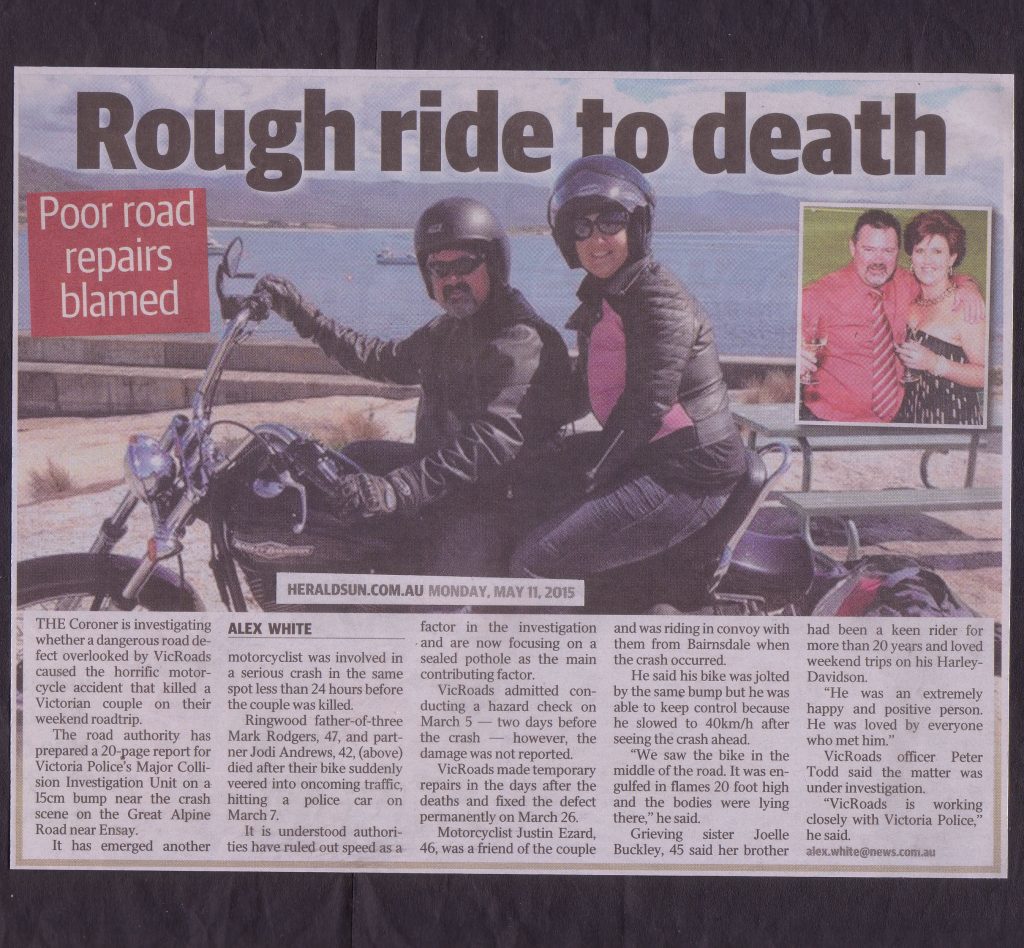
The reform of Australia’s road safety systems has to begin with more comprehensive, more uniform crash investigation systems. No one can develop reliable road trauma countermeasures without reliable traffic and crash data. Better data must be shared with stakeholders. Interested parties must be included in research and development of road trauma countermeasures. Road authorities must be held to account when failures occur.
Damien Codognotto OAM